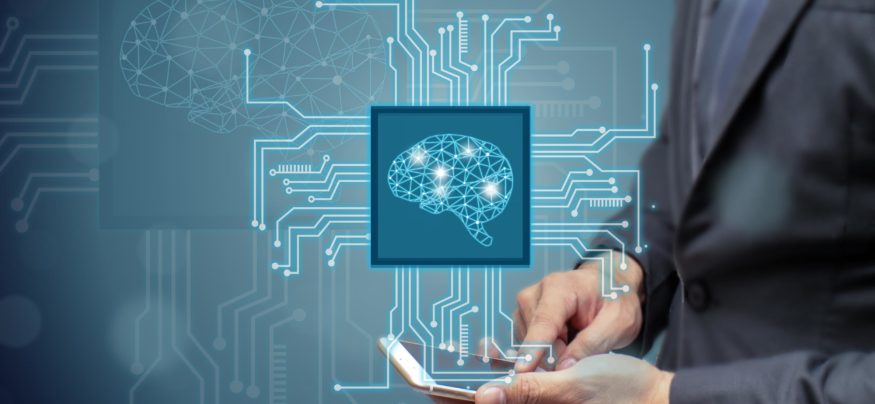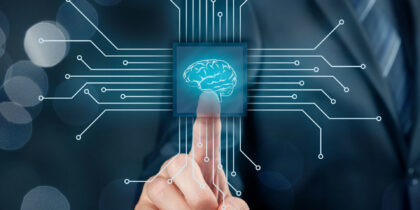In this News Insight, Information Management looks into deep learning and the business possibilities of AI. Understanding AI will be key for businesses to thrive in the Next Mobile Economy. Get your guide to enabling your workforce for the new era of business growth. — Samsung Insights editorial team
Legendary cosmologist Stephen Hawking said it could spell the end of the human race. Transportation industry-disrupting industrialist Elon Musk is worried enough about it to found a billon-dollar nonprofit to keep it in check. However you feel about it, Artificial intelligence and machine learning are more than just hype.
When many people hear the term “artificial intelligence” they envision an intelligent and self-aware, artificial lifeform. However, despite what some of our best minds have said about a possible future, this is still science fiction.
In reality, AI exists today and is being used successfully behind the scenes in many businesses to create efficiencies and reduce costs by automating processes we once thought only humans could do.
The recent growth of AI in business is largely due to advances in deep learning, which is a subset of machine learning. To understand the true potential for AI in our society, and to distinguish the hype from the reality, one must understand deep learning and what makes it revolutionary.
What is Deep Learning
Deep learning is a class of machine learning algorithms that uses a deep neural network in order to learn. A deep neural network is a collection of artificial neurons, which are simply trainable mathematical units. These neurons collectively “learn” complex mathematical functions to map raw input to an output.
Neural networks have existed in machine learning since the 1950s, but today’s “deep” networks have many more stacked layers of neurons than older networks. This enables them to learn much more complex problems requiring computation at a scale that was previously not possible. A typical deep neural network has about eight layers and 60 million parameters, but there are examples of deep neural networks today that have 200 to 400 million parameters!
How Deep Neural Networks Learn
A key difference between conventional neural networks and deep neural networks is how they learn. In a traditional neural network model, the first step is feature extraction.
For example, if we wanted the network to be able to look at an image of a vehicle and determine the make and model, a computer scientist would first need to identify all the features the network would need to know in order to accurately identify the object and engineer them into the model. This is time consuming work and makes it difficult and costly to reengineer features or change rules at any point in the future.
In contrast, with deep neural networks – and specifically a type of deep neural network known as a convolutional neural network – all of those features can be automatically learned by the network, simply by exposing it to a vast amount of data. Rather than the scientist needing to identify and engineer various features into the model, the network does this work itself.
Not only does this remove the time-consuming front-end work, it also typically leads to a much more robust description of each feature as computer vision enables the network to recognize every minor variation of each feature. In other words, with deep learning systems, one can simply provide the network with new examples and more data, and it will learn automatically.
What’s Driving the Rapid Growth of Deep Learning
Though neural networks have existed for decades, the adoption of deep neural networks has grown dramatically within only the past few years. That’s in part due to the recent availability of extremely large data sets, thanks to the widespread use of the Internet and crowdsourcing services.
If one is working with a relatively small data set, there is little difference in the performance between deep neural networks and traditional algorithms or smaller neural networks. However, as the amount of data increases, the performance of those traditional systems will eventually plateau. With a large data set, the performance capabilities and accuracy of deep neural networks begin to skyrocket.
How Deep Learning is Powering AI in Businesses
Because deep learning is so well suited to solving complicated image classification and object recognition challenges, one of the areas where it is being used today is in identity verification and facial comparison technologies.
For example, in the financial services sector, banks are required to verify the identities of their customers in order to comply with anti-money laundering (AML) and know your customer (KYC) regulations. In the past, this meant customers had to visit a bank branch and present their ID to an employee to verify their identity. Not only is this inconvenient for the customer, manual identity verification processes cost banks hundreds of millions of dollars to maintain, as they often had to make tens of thousands of customer calls every month to refresh KYC documents or update incorrect or missing identity information.
But thanks to the advancements in computer vision and the rise of artificial intelligence, many financial institutions are now using digital identity verification solutions powered by deep neural networks. New customers simply use their smartphone camera to scan their IDs, snap a selfie, and then submit these pictures to the bank. Behind the scenes, deep learning algorithms analyze and instantly verify the authenticity of the ID and perform biometric facial comparison to ensure that the individual submitting the documentation is indeed the person pictured on the ID.
Because of the computing power of these deep neural networks, the entire identity verification process is completed in just seconds and done entirely through the digital channel – saving the financial institution tremendous amounts of money, while enabling them to comply with industry regulations and deliver a much better customer experience.
This is just one example of the many ways deep learning and artificial intelligence are being used in businesses to automate processes, create efficiencies, reduce costs and deliver superior experiences and services to customers. As we continue to see the benefits these technologies can provide, the rate of adoption will only increase. More importantly, so will the rate of innovation.
The very researchers who gave rise to the deep learning revolution – individuals like Geoffrey Hinton and Yann LeCun – are already working on the next big advancements in machine learning and the rate of improvement will continue to get better and better. Will these systems eventually doom humanity? Not unless they can achieve the kind of general intelligence and self-awareness that is still no more within the reach of today’s AIs than they were to those of the 1950s. In other words, I don’t think we have to worry just yet.
This article was written by Stephen Ritter from Information Management and was legally licensed through the NewsCred publisher network. Please direct all licensing questions to legal@newscred.com.
Get more insights on trending technology and its impact on business.
![]()







